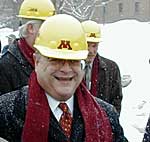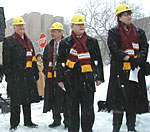at the University, one must first understand its culture. The U, as an institution, is like one of its classrooms where ideas are expected to flow freely and where differing views are not only tolerated, but encouraged. With so much unbridled debate, however, the process of getting something done is often inefficient.
Eighty-two percent of the professors at the U have, or are on track for, that uniquely academic form of permanent job security: tenure. They are a major force that must be consulted on every major move. "In businesses you have a great deal more power of persuasion," says Carlson School of Management Dean David Kidwell, who announced he's leaving before fall 2001. "In a sense, you can fire people, you can sell off divisions. The difference between businesses and universities is in a business situation, it's more of a command situation. At a university, there's more consensus building. Deans that are successful here, have to know consensus building, not only among other deans but with their faculty."
While the faculty is a huge power as a group, the individual who holds the most power at the U is its president, Mark Yudof.
"Everybody appeals to everybody on lot of types of decisions. That doesn't mean that in the last analysis I don't call the shot, but it's highly consultative, much more consultative than any institution I've been involved in the past," says Yudof.
 |
Much of Mark Yudof's power comes from his political skills, which are tested in a budget battle with Gov. Jesse Ventura. Listen to Yudof's response to Gov. Ventura's criticism of spending at the U of M. Yudof made the comments at a meeting of the Board of Regents on February 9, 2001. To hear Gov. Ventura's comments, listen to the February 8, 2001 edition of MPR's Midmorning.
|
Some of Yudof's power is inherent in his prominent position on the organizational chart, but his power also comes from his political skills. Sources say privately that former presidents Ken Keller and Nils Hasselmo were not as successful as Yudof at pleasing the university's varied - and often competing - constituencies. They say Keller, while highly intelligent and creative, was dictatorial and impatient under the often circuitous university system. They describe Hasselmo as an opposite; he failed to make strong decisions and articulate a vision for the university.
H. Ted Davis, dean of the Institute of Technology, says Yudof has struck that delicate balance, in part, by opening the books.
"We all understand where the money is going - why it's needed - and we're all part of the process," says Davis. "So we don't have to see it as only what we got and what we didn't. We can see it in the context of here are the things that are on the table that need to be done and here are the resources we have to divide to do it."
Regardless of how politically savvy a president is, he or she must still answer to the Board of Regents. This body of 12 unpaid legislative appointees is charged with ensuring the university doesn't stray from its missions of education, outreach and research. The Board accomplishes that, in part, by hiring, firing and evaluating presidents; granting professors tenure; opening new departments and setting budgets.
How proposals reach the board of Regents is part of a game with few rules, according to College of Liberal Arts Dean Steven Rosenstone.
"There's multiple forums in which ideas are debated, proposals are discussed. They include consultative discussions with the faculty, with deans, the president's cabinet at the vice-presidential level in particular. And out of all that comes a decision by the president of how he wants to proceed, and that's the decision brought to the Board of Regents, " says Rosenstone.
 |
|
1939: Minnesota Medical Foundation founded to attract donations to the university.
1962: University of Minnesota Foundation created.
1986: Curtis L. Carlson gives $25 million to the University: $13 million earmarked for Carlson School of Management.
1994: Mildred and Bill Peters give $13.5 million for the College of Pharmacy.
1999: University of Minnesota launches "Campaign Minnesota" with the goal of raising $1.3 billion by 2003.
2001: University of Minnesota tops $1 billion mark in Minnesota Campaign.
|
Those are just the players within the university. A whole host of players outside the U influences the university's direction, and they do it largely with money. Take the state, which typically funds one-third of the U's $2 billion annual budget. Gov. Jesse Ventura doesn't want to increase it as much as President Yudof would like.
"When was the last time you heard of a cut at the U? In the private sector, you have to live within a budget. To me, education is not living within a budget. They go to the trough and ask for more and more and more, " Ventura says.
The federal government also wields considerable influence over the U by shaping its research agenda through grants from the National Science Foundation and the National Institutes of Health.
Christine Maziar, vice president for research, says the federal government provides about $300 million, or two-thirds of the U's outside-funded research.
"We anticipate that at the national level there'll be major new investments in the fields of genomics, cellular and molecular biology. So it's very important for the U to hire faculty in these areas where there'll be sufficient research funding, " says Maziar.
Maziar says about 10 percent of the university's research money comes from private business and industry. She say it's an important component that she'd like to see grow within tight limits.
Sandra Gardebring, vice president for institutional relations, cautions that taking too much money from private business could create a perception that the U is a research entity for hire.
"It's different when individual corporate entities say, 'We need research on X and we'll give you $2 million if you do research on X.' And we do some of that and there's nothing ethically wrong with that. It's just if that consumes too large of a piece of the research puzzle, I would be worried about it, " says Gardebring.
 |
February 2001's groundbreaking of the Microbial and Plant Genomics Building on the St Paul campus was made possible by a $10 million gift from Cargill, a gift that came with no strings attached.
See a list of major donors to the U of M.
|
The groundbreaking in February 2001 of the Microbial and Plant Genomics Building on the St. Paul campus was made possible by a $10 million gift from Cargill, a gift that came with no strings attached. Cargill, along with other companies and alumni, give money to the U as outright gifts used - among other things - to hire star professors. In 1962, a group of private individuals met with then U of M President Meredith Wilson and created the University of Minnesota Foundation. In January 2001, the university hit its $1 billion mark as part of a campaign to raise $1.3 billion by 2003.
Numerous individuals interviewed for this story barely mentioned one group as being a "major player" at the U: students. Twin Cities campus student body president Matt Clark says he's not surprised.
"It's because we have other responsibilities, " says Clark. "To come to college a lot of us have two part-time jobs. In addition to going to school, we're parents. Those are impediments to be active in the '60s on the Berkeley campus. We're also a commuter campus. I truly believe that if we were a resident campus, students would take a greater role in what's happening, because of that sense of place."
But one university administrator says it's a big mistake to say that students don't rank as one of the U's major powers. Students, he says, influence the U with their feet by deciding what programs to enroll in, what classes to take and ultimately whether to attend the University of Minnesota at all.